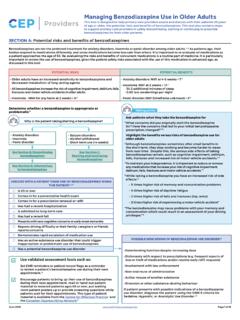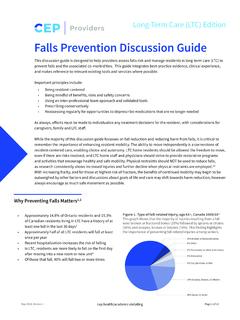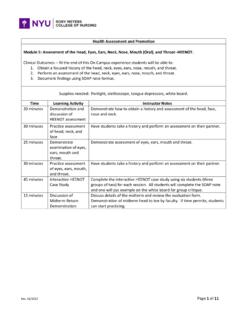Transcription of Clinically Organized Relevant Exam (CORE) Back Tool
1 2016 Page 1 of 4 Clinically Organized Relevant Exam ( core ) Back ToolThis tool will guide the family physician and/or nurse practitioner to recognize common mechanical back pain syndromes and screen for other conditions where management may include investigations, referrals and specific medications. This is a focused examination for clinical decision-making in primary care. NIFTI is a mnemonic for common red flags Red flags indicate the potential presence of an underlying serious pathology Cauda Equina symptoms require urgent surgical evaluation Yellow flags indicate the potential of psychosocial risk factors for developing chronic pain Yellow flags can be picked up on any visit If significant, CBT or 1:1 psychoeducation counselling may be necessary for pain managementYellow FlagsRed Flags A patient s history can help identify: Back or leg dominant pain Intermittent or constant pain Associated aggravating movement Non-mechanical vs.
2 Mechanical pain Red flags ( ) and yellow flags ( )Section A: History An examination refutes or supports the back pain pattern identified in history Referred leg pain will have a normal neurological exam Radicular (nerve) pain will have a positive straight leg raise (SLR) with reproduction of leg pain and possible abnormal neurological signs Interpretation of range of motion includes the pain response to flexion and extension movementsSection B: Physical ExaminationSupporting MaterialOverview of Tool and Key PointsOpioid Risk Tool 1 Patient Education Inventory 2 Personal Action Planning for Patient Self Management 3 The Keele STarT Back Screening Tool 4 Supporting ToolsPharmacy Table: Acute and Subacute Low Back Pain Phamacological Alternatives 5 Pharmacy Table: Acute and Subacute Low Back Pain Topical and Herbal Products 6 Evidence Summary for Management of Non-specific Chronic Low Back Pain 7 Opioid Manager Switching Opioids Form 8 Additional Tools For ProvidersBack Book 9 General Recommendations for Maintaining a Healthy Back 10So Your Back 11 What You Should Know About Acute Pain 12 What You Should Know About Chronic Pain 13 Imaging Tests for Lower Back Pain: When You Need Them And When You Don t 14Dr.
3 Mike Evans Low Back Pain Patient Self-Management Video 15 Additional Tools For Patients Goals may include to reduce pain and to increase activity Frequent movement in small doses recommended Self management involves patient driven goals for motivating behaviour change like exercise, medication compliance or activity modification Remember that all recovery positions and/or exercises should be customized to the individual patient. This section offers a starting point with links to additional resourcesSection C: Initial Management Based on your findings, the patient may require referral to: rehabilitation surgery specialist(s) imaging or laboratory testsSection D: Referrals (if required) Throughout this tool, key messages for your patient are embedded in each section as indicated by a key symbol ( ).12 3non-mechanical painIf pattern of pain is not identified, patient has A: History Red Flags (check if positive)Section B: Physical Examination 19 Where is your pain the worst?
4 16Is your pain constant or intermittent? 16 What increases your typical pain? 16q Back/ Buttock Dominantq Constantq Noq Flexion (possibly also Extension)q Constantq All movements hurtq Intermittentq Yesq Extension onlyq Intermittentq Leg DominantIf improved with prone extension, will respond faster. Pattern 1 Pattern 2 Pattern 3 Pattern 4If improved with rest positions, surgical treatment less with sitting or patient with a positive yellow flag will benefit from education and reassurance to reduce risk of chronicity. If yellow flags persist, consider additional resources: Keele StarT Back 4 ; The Patient Health Questionnaire for Depression and Anxiety (PHQ-4). 25q No Rule out Cauda Equina Syndrome Rule out Yellow Flagsq Yesq No Systemic Inflammatory Arthritis Screen 18q YesPage 2 of Why?
5 Q Back/Buttock Pain q Leg PainConfirm this is consistent with Question 1 IndicationInvestigationq Neurological: diffuse motor/sensory loss, progressive neurological deficits, cauda equina syndromeUrgent MRI indicatedq Infection: fever, IV drug use, immune suppressedX-ray and MRIq Fracture: trauma, osteoporosis risk/fragility fractureX-ray and may require CT scanq Tumour: hx of cancer, unexplained weight loss, significant unexpected night pain, severe fatigueX-ray and MRIq Inflammation: chronic low back pain > 3 months, age of onset < 45, morning stiffness > 30 minutes, improves with exercise, disproportionate night painRheumatology Consultation and Guidelines Questions to askLook for Do you think your pain will improve or become worse? Belief that back pain is harmful or potentially severely disabling. Do you think you would benefit from activity, movement or exercise?
6 Fear and avoidance of activity or movement. How are you emotionally coping with your back pain? Tendency to low mood and withdrawal from social interaction. What treatments or activities do you think will help you recover? Expectation of passive treatment(s) rather than a belief that active participation will 1:Question 2:Question 3:Question 4:Question 5:Question 6:Is there anything you can NOT do now that you could do before the onset of your low back pain? 16 Have you had any unexpected accidents with your bowel or bladder function since this episode of your low back pain started? 16If age of onset < 45 years, are you experiencing morning stiffness in your back > 30 minutes? 17 Yellow Flags 21, 22, 24 Psychosocial Risk Factors for Developing Chronicityq No red flagsq No yellow flagsAcute Cauda Equina syndrome is a surgical emergency.
7 23 Symptoms are:q Urinary retention followed by insensible urinary overflowq Unrecognized fecal incontinenceq Distinct loss of saddle/perineal sensationThe acronym NIFTI can help you remember red flags. 21, 22, 42, 43 Work through questions 1 6 to evaluate the patient s those with low back pain > 6 weeks or non-responsive to treatment, consider asking: Rule out red flags Rule out red flagsq Walking and/or StandingAdditional FindingsAbnormalLRGaitHeel Walking (L4-5)Toe Walking (S1)StandingMovement testing in flexionMovement testing in extensionTrendelenburg test (L5) Repeated toe raises (S1)SittingPatellar reflex (L3-4)Quadriceps power (L3-4)Ankle dorsiflexion power (L4-5)Great toe extension power (L5)Great toe flexion power (S1)Plantar response, upper motor testKneelingAnkle reflex (S1)LyingSupinePassive straight leg raise (SLR)Passive hip range of motion Prone Femoral nerve stretch (L3-4)Gluteus maximus power (S1) Saddle sensation testing (S2-3-4) Passive back extension (patient uses arms to elevate upper body)NOTE.
8 Bolded green-coloured tests are the suggested minimum requirements of the 2016 Imaging tests like X- rays, CT scans and MRIs are not helpful for recovery or management of acute or recurring low back pain unless there are signs of serious pathology. 14, 41 Your examination today does not demonstrate that there are any red flags present to indicate serious patholog y, but if your symptoms persist for > 6 weeks, schedule a follow-up appointment. 14, 41If you are feeling symptoms of sadness or anxiety, this could be related to your condition and could impact your recovery, schedule a follow-up appointment.: Key message for your patientPatient Name: _____Chart #: _____Date of Birth: _____ Date of Visit: _____121233 Continue reviewing historyContinue reviewing historyStamp or fill C: Initial Management 16, 19, 26 Provider Name: Provider Signature.
9 March 2016 Page 3 of 4 Non-Mechanical PainConsider other etiologies prior to pain medicationsConsider centralized pain medications ( anti-depressants, anti-seizure, opioids)Consider internal organ pain referral such as kidney, uterus, bowel, ovariesConsider pain disorderq Non-spine related painq Spine pain does not fit mechanical patternq Absence of red flagsq Pain is managed well so that patient can tolerate treatmentq Pain has mechanical directional preference varies with movement, position or activityq Patient is ready to be an active partner in goal setting and self managementq Failure to respond to evidence based compliant conservative care of at least 12 weeksq Unbearable constant leg dominant painq Worsening nerve irritation tests (SLR or femoral nerve stretch)q Expanding motor, sensory or reflex deficitsq Recurrent disabling sciaticaq Disabling neurogenic claudicationq Surgical referralq Imaging (Refer to red flags)q Laboratory tests (Refer to red flags)
10 Q Rehabilitation referralq Physiatryq Cognitive Behavioural Therapyq Pain specialistPattern 1 Pattern 2 Pattern 3 Pattern 4 Commonly Called 27 Disc PainFacet Joint PainCompressed Nerve PainSymptomatic Spinal Stenosis (Neurogenic Claudication)Medication 5, 6, 7q Acetaminophenq NSAIDq Acetaminophenq NSAIDq May require opioids if 1st line pain meds not sufficientq Acetaminophenq NSAIDR ecovery Positions 28 Starter Exercises 29 Repeated prone lying passive extensions ( hips on ground, arms straight). 10 reps, 3 x daySitting in a chair, bend forward and stretch in flexion. Use hands on knees to push trunk upright. Small frequent repetitions through the day Z lie (see image above)Caution: exercise will aggravate the pain so start with pain reducing positionsRest in a seated or other flexed position to relieve the leg painExercisesISAEC 35; HealthLink BC 34; SASK Pattern 1 30 ISAEC 35; HealthLink BC 34; SASK Pattern 2 31 ISAEC 35; HealthLink BC 34; SASK Pattern 3 32 ISAEC 35; HealthLink BC 34; SASK Pattern 4 33 Functional Activities 36q Encourage short frequent walkingq Reduce sitting activitiesq Use extension roll for short duration sittingq Encourage sitting or standing with foot stoolq Reduce back extension and overhead reachq Change positions frequently from sit to stand to lie to walk q Use support with walking or standing.




